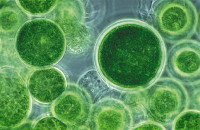| Description | Participants | Agenda | Summary | Products |
|---|
NIMBioS Investigative Workshop
Many-cell System Modeling

Topic: Applying high-performance computing to the modeling and simulation of billion-cell living systems
Meeting dates: July 7-9, 2015
Location: NIMBioS at the University of Tennessee, Knoxville
Organizers:
- Simon Kahan, Computer Science and Engineering, Univ. of Washington; Northwest Inst. for Advanced Computing
- Nicholas S. Flann, Computer Science, Utah State Univ., Logan
- Andrea Hawkins-Daarud, Swanson Lab, Feinberg School of Medicine, Northwestern Univ.
- Russell Rockne, Information Sciences, Mathematical Oncology, Beckman Research Inst., City of Hope, Duarte, CA
- Ryan Tasseff, Procter and Gamble
Objectives: Biologists understand many rules governing single cell behavior. Knowledge about cell-cell and cell-environment interactions is rapidly accumulating. Given clearly stated rules and empirical data, mathematicians formulate models for living systems expressed as equations. Computational scientists then perform simulations solving these equations to predict collective behavior over time. When billions of cells must be simulated to reproduce emergent behaviors, computational challenges can become overwhelming. Questions then arise: When is cell-scale precision required to explain or predict collective phenomena? What approximate (continuous) methods can be applied instead, and when do they fall short? What methods exist to conduct many-cell simulations directly? Computational scientists can adapt both continuum and discrete agent-based simulation codes to high performance computing (HPC) environments. Careful adaptation has the potential to bridge the gap between one and one-billion cells, but corresponding models must also be developed. This workshop brought together modelers, computer scientists and scientific computing experts to discuss state of the art modeling and simulation of many-cell living systems. Some practitioners use ad hoc methods to build and simulate models using general frameworks such as MATLAB, FLAME, and C++. Others use paradigm-specific platforms such as CompuCell, Morpheus, and Biocellion. Participants learned from shared experiences, matched methodologies to modeling problems, and matched skills to modeling challenges. Workshop results and the new relationships formed will serve as a foundation for future work in addressing the challenges of moving from small-scale multicellular models to modeling whole organisms and communities.
 Many-cell System Modeling WordPress site
Many-cell System Modeling WordPress site
![]() Live Stream. Selected presentations were streamed live during the Workshop and were archived for online viewing.
Live Stream. Selected presentations were streamed live during the Workshop and were archived for online viewing.
 Summary Report. This workshop brought together investigators, students and trainees to discuss challenges in mathematical
modeling of many-cell living systems. Modeling domains included cancer, embryonic stem cells, microbial and yeast communities, skin, kidneys, and liver. The workshop lasted three days, each with a theme and a keynote speaker. Topics on day one were getting on the same page, reviewing the state of the art with James Glazier (presented by Maciej Swat). Day two topics were barriers to advancement, defining challenges with Paul Macklin. Day three topics were call to action and moving beyond the state of the art with Ilya Shmulevich. The workshop included activities that were both didactic and interactive, with lightning talks (two minutes, one slide), short talks (15 minutes), structured debates, and a combined software demo and poster session to encourage interaction among participants. Breakout sessions on specific topics produced proposals for future NIMBioS supported working groups and scientific collaborations included focus areas of math/bio education, the application of high performance computing to large scale agent-based systems, and the creation of a public resource (wiki) for modeling “tips and tricks,” all intended to increase momentum and forward progress in the field.
Summary Report. This workshop brought together investigators, students and trainees to discuss challenges in mathematical
modeling of many-cell living systems. Modeling domains included cancer, embryonic stem cells, microbial and yeast communities, skin, kidneys, and liver. The workshop lasted three days, each with a theme and a keynote speaker. Topics on day one were getting on the same page, reviewing the state of the art with James Glazier (presented by Maciej Swat). Day two topics were barriers to advancement, defining challenges with Paul Macklin. Day three topics were call to action and moving beyond the state of the art with Ilya Shmulevich. The workshop included activities that were both didactic and interactive, with lightning talks (two minutes, one slide), short talks (15 minutes), structured debates, and a combined software demo and poster session to encourage interaction among participants. Breakout sessions on specific topics produced proposals for future NIMBioS supported working groups and scientific collaborations included focus areas of math/bio education, the application of high performance computing to large scale agent-based systems, and the creation of a public resource (wiki) for modeling “tips and tricks,” all intended to increase momentum and forward progress in the field.
NIMBioS Investigative Workshops focus on broad topics or a set of related topics, summarizing/synthesizing the state of the art and identifying future directions. Workshops have up to 35 participants. Organizers and key invited researchers make up half the participants; the remaining participants are filled through open application from the scientific community. Open applicants selected to attend are notified by NIMBioS within two weeks of the application deadline. Investigative Workshops have the potential for leading to one or more future Working Groups. Individuals with a strong interest in the topic, including post-docs and graduate students, are encouraged to apply. If needed, NIMBioS can provide support (travel, meals, lodging) for Workshop attendees, whether from a non-profit or for-profit organization.
A goal of NIMBioS is to enhance the cadre of researchers capable of interdisciplinary efforts across mathematics and biology. As part of this goal, NIMBioS is committed to promoting diversity in all its activities. Diversity is considered in all its aspects, social and scientific, including gender, ethnicity, scientific field, career stage, geography and type of home institution. Questions regarding diversity issues should be directed to diversity@nimbios.org. You can read more about our Diversity Plan on our NIMBioS Policies web page. The NIMBioS building is fully handicapped accessible.
NIMBioS
1122 Volunteer Blvd., Suite 106
University of Tennessee
Knoxville,
TN 37996-3410
PH: (865) 974-9334
FAX: (865) 974-9461
Contact NIMBioS


